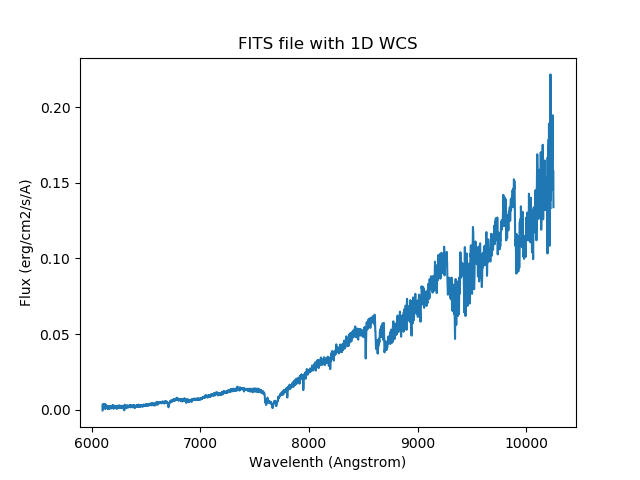Loading and Defining Custom Spectral File Formats¶
Loading From a File¶
Specutils leverages the astropy io registry to provide an interface for conveniently
loading data from files. To create a custom loader, the user must define it in
a separate python file and place the file in their ~/.specutils directory.
Loading from a FITS File¶
A spectra with a Linear Wavelength Solution can be read using the read
method of the Spectrum1D class to parse the file name and
format
import os
from specutils import Spectrum1D
file_path = os.path.join('path/to/folder', 'file_with_1d_wcs.fits')
spec = Spectrum1D.read(file_path, format='wcs1d-fits')
This will create a Spectrum1D object that you can manipulate later.
For instance, you could plot the spectrum.
import matplotlib.pyplot as plt
plt.title('FITS file with 1D WCS')
plt.xlabel('Wavelength (Angstrom)')
plt.ylabel('Flux (erg/cm2/s/A)')
plt.plot(spec.wavelength, spec.flux)
plt.show()

Creating a Custom Loader¶
Defining a custom loader consists of importing the
data_loader decorator from specutils and attaching
it to a function that knows how to parse the user’s data. The return object
of this function must be a Spectrum1D object.
Optionally, the user may define an identifier function. This function acts to ensure that the data file being loaded is compatible with the loader function.
# ~/.specutils/my_custom_loader.py
import os
import six
from astropy.io import fits
from astropy.nddata import StdDevUncertainty
from astropy.table import Table
from astropy.units import Unit
from astropy.wcs import WCS
from specutils.io.registers import data_loader
from specutils import Spectrum1D
# Define an optional identifier. If made specific enough, this circumvents the
# need to add ``format="my-format"`` in the ``Spectrum1D.read`` call.
def identify_generic_fits(origin, *args, **kwargs):
return (isinstance(args[0], six.string_types) and
os.path.splitext(args[0].lower())[1] == '.fits')
@data_loader("my-format", identifier=identify_generic_fits)
def generic_fits(file_name, **kwargs):
name = os.path.basename(file_name.rstrip(os.sep)).rsplit('.', 1)[0]
with fits.open(file_name, **kwargs) as hdulist:
header = hdulist[0].header
tab = Table.read(file_name)
meta = {'header': header}
wcs = WCS(hdulist[0].header)
uncertainty = StdDevUncertainty(tab["err"])
data = tab["flux"] * Unit("Jy")
return Spectrum1D(flux=data, wcs=wcs, uncertainty=uncertainty, meta=meta)
After placing this python file in the user’s ~/.specutils directory, it
can be utilized by referencing its name in the read method of the
Spectrum1D class
from specutils import Spectrum1D
spec = Spectrum1D.read("path/to/data", format="my-format")
Creating a Custom Writer¶
Similar to creating a custom loader, a custom data writer may also be defined.
This again will be done in a separate python file and placed in the user’s
~/.specutils directory to be loaded into the astropy io registry.
# ~/.spectacle/my_writer.py
from astropy.table import Table
from specutils.io.registers import custom_writer
@custom_writer("fits-writer")
def generic_fits(spectrum, file_name, **kwargs):
flux = spectrum.flux.value
disp = spectrum.dispersion.value
meta = spectrum.meta
tab = Table([disp, flux], names=("dispersion", "flux"), meta=meta)
tab.write(file_name, format="fits")
The custom writer can be used by passing the name of the custom writer to the
format argument of the write method on the
Spectrum1D.
spec = Spectrum1D(flux=np.random.sample(100) * u.Jy,
spectral_axis=np.arange(100) * u.AA)
spec.write("my_output.fits", format="fits-writer")
Reference/API¶
A module containing the mechanics of the specutils io registry.
Functions¶
data_loader(label[, identifier, dtype]) |
Wraps a function that can be added to an registry for custom file reading. |
custom_writer(label[, dtype]) |